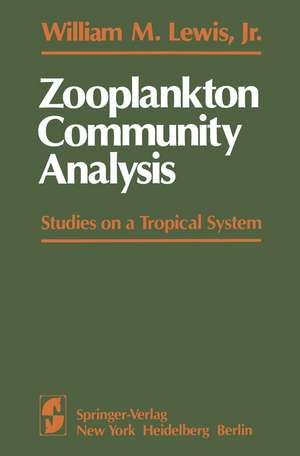Zooplankton Community Analysis: Studies on a Tropical System
Autor W. M. Jr. Lewisen Limba Engleză Paperback – 5 noi 2011
Preț: 634.49 lei
Preț vechi: 746.47 lei
-15% Nou
Puncte Express: 952
Preț estimativ în valută:
121.43€ • 126.30$ • 100.24£
121.43€ • 126.30$ • 100.24£
Carte tipărită la comandă
Livrare economică 15-29 aprilie
Preluare comenzi: 021 569.72.76
Specificații
ISBN-13: 9781461299882
ISBN-10: 1461299888
Pagini: 176
Ilustrații: X, 164 p.
Dimensiuni: 155 x 235 x 9 mm
Greutate: 0.25 kg
Ediția:Softcover reprint of the original 1st ed. 1979
Editura: Springer
Colecția Springer
Locul publicării:New York, NY, United States
ISBN-10: 1461299888
Pagini: 176
Ilustrații: X, 164 p.
Dimensiuni: 155 x 235 x 9 mm
Greutate: 0.25 kg
Ediția:Softcover reprint of the original 1st ed. 1979
Editura: Springer
Colecția Springer
Locul publicării:New York, NY, United States
Public țintă
ResearchDescriere
This book is based on the premise that the study of ecological communities should be a composite analysis of system properties (community structure, community energetics) and population properties (life history patterns, adaptive strategies) backed by a thorough understanding of the physical chemical environment. Too frequently community ecology takes a much narrower focus. This may partly be the result of perceived antagonisms between schools of thought in ecology. Despite their rather separate origins, the multiple theoretical and methodological tools that now exist must be applied synthetically to real communities if the progress of the past two decades is to continue into the next two. This book has a case history format, which increases the opportunity for detailed analysis, although I have attempted to maintain the general per spective of a community ecologist and to draw extensively from the literature whenever it seems profitable to do so. The case history data are for Lake Lanao, a large tropical lake. The main zooplankton data base used in the analysis is entirely original and unpublished, although the detailed support ing data on the physical-chemical environment and the phytoplankton com munity have been presented in numerous journal articles and are thus abstracted or used selectively to meet the needs of zooplankton community analysis.
Cuprins
1 Introduction.- 2 General Description of Lake Lanao.- 3 The Phytoplankton Community.- Community Composition.- Biomass.- Succession.- 4 Description of the Zooplankton Community.- Community Complexity.- Copepods.- Rotifers and Cladocera.- Miscellaneous Zooplankton.- 5 Methods.- Sampling.- Counting.- Size and Biomass Measurements.- 6 Spatial Distribution of the Zooplankton.- Vertical Distribution.- Horizontal Variation: Fixed Patterns.- Horizontal Variation: Ephemeral Patterns.- Overview of Horizontal Variation.- 7 Zooplankton Abundance Trends.- 8 Zooplankton Development Rates.- Cyclopoids.- Calanoids.- Chaoborus.- Rotifers and Cladocera.- 9 Secondary Production.- Computations: Copepods and Chaoborus.- Computations: Rotifers.- Computations: Cladocera.- Results: Copepods and Chaoborus.- Results: Rotifers and Cladocera.- 10 Similarities in Zooplankton Abundances and Productivities.- The N Matrix.- The ?N Matrix.- The P Matrix.- The ?P Matrix.- Summary of Similarities.- 11 Zooplankton Mortality Rates.- Computations: Copepods.- Computations: Chaoborus.- Computations: Rotifers and Cladocera.- Copepod Mortality Rates.- Chaoborus Mortality Rates.- Rotifer and Cladoceran Mortality Rates.- Overview of Mortality Rates.- 12 Zooplankton Mortality Mechanisms.- Predation Mortality.- Mechanisms of Mortality Other Than Predation.- 13 Community Trends in Mortality.- 14 Control of Zooplankton Production by Food Quantity and Quality.- Analytical Methods: Herbivores.- Importance of Major Phytoplankton Taxonomic Groups as Herbivore Foods.- Importance of Different Phytoplankton Size Fractions as Herbivore Foods.- Importance of Individual Phytoplankton Species as Herbivore Foods.- Importance of Food in Determining Primary Carnivore Production.- 15 Community Trends in Growth and Reproduction.- Trends in Absolute Production.- Trends in Relative Production.- Trends in Birth Rate.- 16 Conclusion and Synthesis.- Energy Flow and Biomass.- Community Structure and Organization.- Rules Governing Structure of the Herbivore Component.- Control Pathways in the Ecosystem.- Summary.- References.- Author Index.















